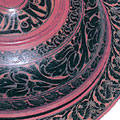In the cold hill areas of Nepal the common nettle (chalne sisnu/ Urtica dioica) is processed and woven into cloth, blankets, sleeping bags, and ropes. This greyish, rough, and warm woven textile provides long years of hardy wear and tear.
RAW MATERIAL
Bhangra cloth is made from the fibres of the common nettle or sisnu, a plant much smaller than the allo. The chalne sisnu or stinging nettle plants or grow wild to a height of up to 2 m and are found throughout the temperate regions of Nepal. The stem (about 0.5-1.0 cm in diameter) is downy and covered with stinging hairs.
PROCESS & TECHNIQUE
In September and October, the nettle stalks are cut in the forests, the leaves removed, and the outer bark peeled off. The bark is partially dried in the sun and boiled with ash in a big cauldron (taulo/ khadkaunlo). When the fibres are partially digested, they are beaten thoroughly with a wooden hammer or mugro over a flat stone slab. This process yields the soft, furry, grey fibres that resemble cotton. The fibre is dried in the sun and converted into yarn on a spinning wheel; the cloth is subsequently woven on a loom (tan).


